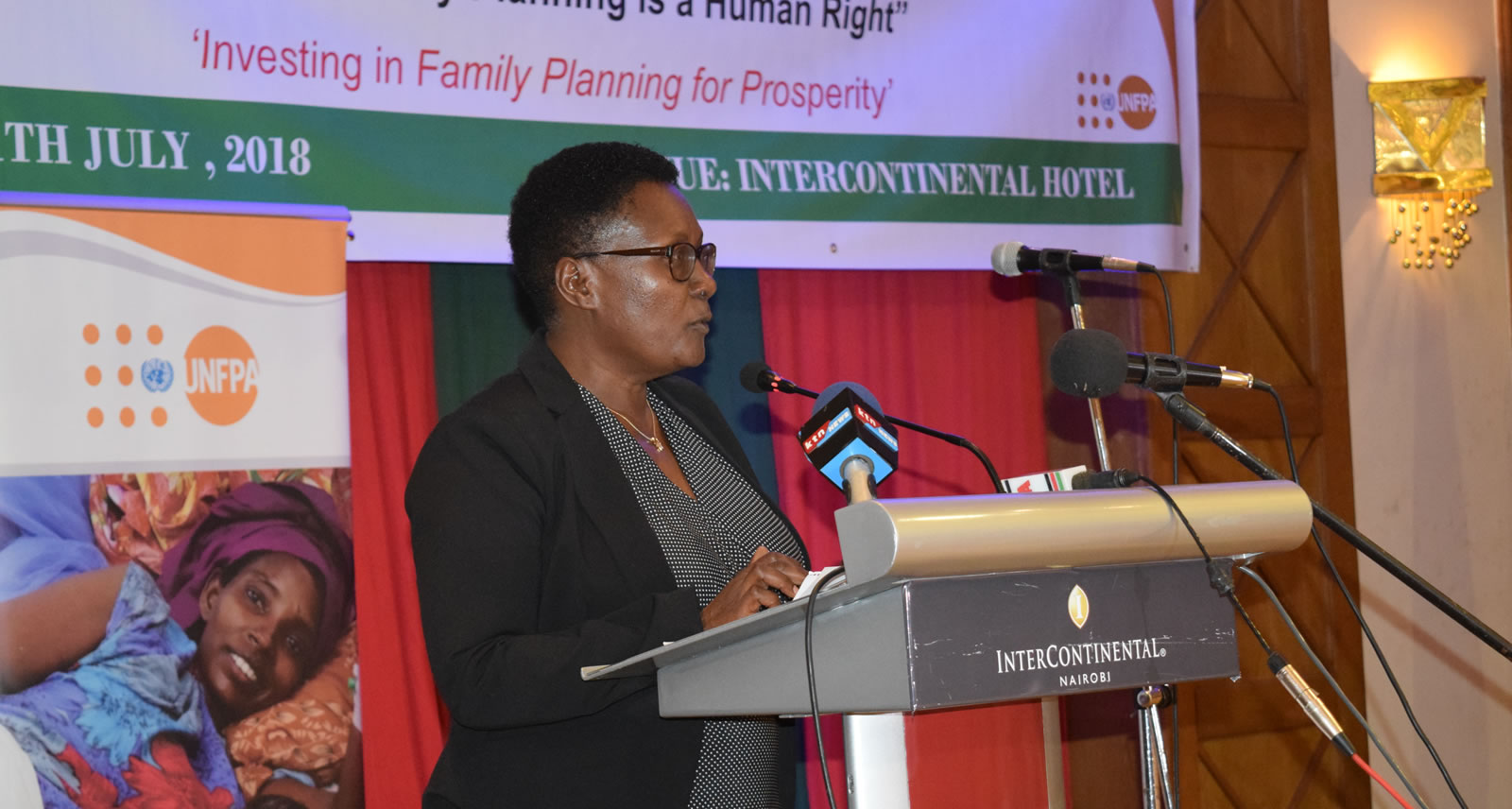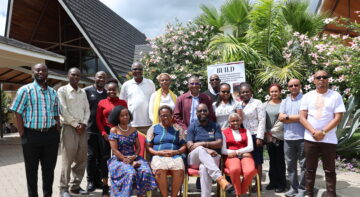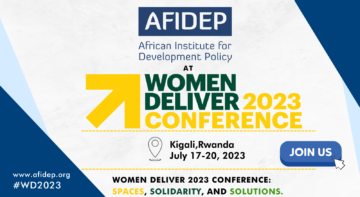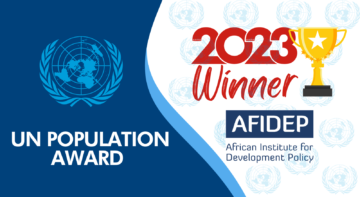News

On 13 May 1968, the United Nations United Nations International Conference on Human Rights resolved in the Proclamation of Teheran: “Parents have a basic human right to determine freely and responsibly the number and the spacing of their children.”
This year, various stakeholders in population and development are commemorating this shift in the value of family planning as a fundamental human right as they celebrate World Population Day, marked on 11 July 2018.
In Nairobi, Kenya, the National Council for Population and Development (NCPD), under the leadership of the Director General, Dr. Josephine Kibaru-Mbae, convened their partners for the celebrations. The event was presided over by Mr. Nelson Gaichuhie, the Chief Administrative Secretary, the National Treasury and Planning, as chief guest. In attendance was the United National Population Fund (UNFPA) Deputy Representative. AFIDEP’s Executive Director, Dr. Eliya Zulu also attended the event.
Family planning data for decision-making
A key part of the discussions was the importance of anchoring family planning policy and programme decisions on robust data. This discussion was led by Professor Peter Gichangi, the Country Director and Director of Science and Research at the International Centre for Reproductive Health Kenya (ICRHK). He emphasised the importance of ensuring data is timely, frequent, of high quality, sustainable, and available at all levels of decision-making.
The main sources of data for Kenya are the Kenya Demographic and Health Survey (KDHS), which is conducted every 5 years, and the District Health Information System (DHIS II). There also exists adhoc data collection commissioned by government and other stakeholders.
Prof. Gichangi also presented data from the PMA2020, the performance, monitoring and accountability mechanism that supporting the goals of Family Planning 2020 (FP2020). FP2020 is a global partnership that supports the rights of women and girls to decide, freely, and for themselves, whether, when, and how many children they want to have. FP2020 works with governments, civil society, multi-lateral organisations, donors, the private sector, and the research and development community to enable 120 million more women and girls to use contraceptives by 2020. FP2020 is an outcome of the 2012 London Summit on Family Planning where more than 20 governments made commitments to address the policy, financing, delivery and socio-cultural barriers to women accessing contraceptive information, services and supplies.
In Kenya, PMA2020 collects data on demand and use of contraceptives at household level, service delivery at service points, among other key indicators. According to the data, there has been an increase in the use of long-acting reversible contraceptives among all women of reproductive age, from 10% in 2014 to 17% in 2016. The unmet need for contraceptives has also decreased from 17.5% to 14.9%. Women with unmet need are those who want to stop or delay childbearing but are not using any method of contraception. Unmet need has been decreasing for both married women and all women of reproductive age.
A key highlight of the data is that there exist major disparities in the use of contraceptives among rural women as compared to urban women. For instance, rural adolescent girls and young women start to use contraceptives six years after first sex, compared to their urban counterparts who start to use contraceptives three and a half years after first sex. The rural adolescents and young women also start having sex earlier, at 16.7 years old, while their urban counterparts have their first sex at 18.4 years. These disparities also predispose rural adolescent girls and young women to early and unintended pregnancies. This data therefore sheds light on major gaps that need urgent policy and programme interventions.
Declining funding for family planning a threat to progress
As noted by Dr. Joel Gondi, the Head, Reproductive and Maternal Health Services Unit (RHMSU) at the Ministry of Health, Kenya is nearly meeting its 2020 target for contraceptive prevalence rate in 2018. For instance, currently, 70% of women of reproductive age have access to 3 to 4 contraceptive methods to choose from. This speaks to the impact of the policy and programme interventions in family planning over the years. However, the greatest threat to this progress is the continuous decline in family planning funding “ a decline from 7 million USD to 1 million USD annually. As such, the national and county governments need to make more investments in family planning commodities, especially at the county level. Dr. Gondi called on the private sector to contribute to financing of family planning programmes. “Let us not rely on the exchequer alone,” he urged. Kenya needs Kshs. 2.3 billion to achieve 100% contraceptive coverage.
Dr. Gondi reiterated the need to address the existing disparities in access and use of contraceptives across different demographic groups, and regions. Besides the disparities in contraceptive use among adolescents, regional disparities are also glaring. For instance, Mandera County has a contraceptive prevalence rate of 2% while Kirinyaga’s is at 80%. Investments are therefore needed to pull those counties that are lagging behind.
Speaking on the importance of addressing gaps in access to contraceptives among adolescents and youth, Dr. Kibaru-Mbae noted that family planning and child spacing are critical for development, especially in tapping into the potential of Kenya’s youth. “Contraception for youth is their right”¦we are not doing them a favour,” she said.
Delivering more with less
For Kenya to overcome the existing challenges, particularly in contraceptive use among adolescents, Dr. Gondi noted stakeholders need to harmonise their communication and speak in one voice when engaging with government and other critical groups. This is especially crucial with the prevailing lack of consensus on providing adolescents with access to contraceptives, with much of the opposition coming from religious groups.
Stakeholders also need to employ innovations to ensure the delivery of family planning programming in an efficient manner, with more benefits and less resources. This calls for increased partnerships with the private sector and other players.
In his remarks, Mr. Gaichuhie emphasised on the government’s prioritisation of universal health coverage (UHC) as part of the Big Four Agenda. He posed that the implementation of programmes under the “Big Four’ will therefore accelerate the realisation of national and global development goals on health and wellbeing, including family planning.
Family planning and Kenya’s future
Further, Mr. Gaichuhie lauded the fact that Kenya’s demographic dividend roadmap developed by NCDP and other stakeholders, presents guidelines that are in tandem with Kenya’s Vision 2030 and other global commitments. He noted that the government shall put in place mechanisms to facilitate the implementation of the demographic dividend roadmap, which includes critical investments in family planning. “If we invest in family planning, this will speed up the reduction of poverty in [Kenya] and the achievement of national and global development goals,” he concluded.
As stakeholders carry on with conversations and advocacy on family planning as a human right, it will be critical to emphasise on the use of a right-based approach to family planning. More advocacy and culture-sensitive messaging are also needed to ensure those opposed to family planning, or birth-spacing as some prefer, understand that family planning is a human right, saves lives, and also empowers women to access education, livelihood opportunities, and contribute to development.
Related Posts





